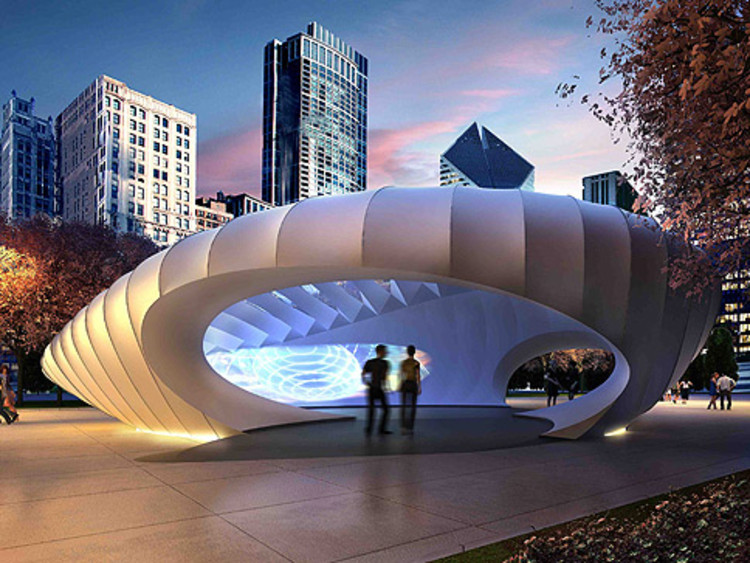

We introduced the Burnham Plan Pavilions designed by Zaha Hadid and UNStudio a few months ago, and now, both are almost ready to be opened to the public. Continuing Millenium Park’s tradition of displaying dynamic public art, the pavilions emphasize bettering the future, which echo the ideals of the 1909 Burnham Plan. Although opening day was June 19th, only UNStudio’s pavilion was complete, as Hadid’s pavilion will require a few more weeks until it will be opened to the public due to its geometric complexities.
More about each pavilion after the break.
Inspired by Chicago’s diagonal city streets, Hadid’s pavilion extends the drawn line of one of the diagonals as if that street ran through the Millennium Park. That line, taken from the Burnham’s drawings, creates the structural ribs and openings in the roof. “By using methods of overlaying, complexity is built up and inscribed in the structure,” explained Hadid.
Constructed from recyclable materials, the outer and inner shells of Hadid’s pavilion are made of tensioned fabric stretched tightly over the curved aluminum framework. A media installation, by artist Thomas Gray, projects films that reflect Chicago’s transformation on the fabric through the day. However, the complex geometries of the tensioned fabric have caused delay in the construction process. The pavilion is not expected to open until at least mid-July; yet, it may remain open until mid-November to compensate for its late opening.

However, UNStudio’s pavilion was finished on time for the opening ceremony. “The UNStudio Burnham Pavilion relates to diverse city contexts, program and scales. It invites people to gather, walk around and through and to explore and observe. The pavilion is sculptural, highly accessible and functions as an urban activator,” explained Ben van Berkel.

The openings in the pavilion’s roof provide framed views of the Chicago skyline while an interactive lighting system in the floor emphasizes the form. Like Hadid’s pavilion, UNStudio’s is also made of recycled materials. The pavilion’s plywood ribs are covered with a plywood skin and coated in reflective paint. All steel pieces, such as the foundation components, will be reused once the exhibit ends.
To read more about the pavilions visit the Burnham Plan Centennial. Images from Chicago Tribune for Hadid and UNStudio.
Credits for Pavilion Design by Zaha Hadid and Patrik Schumacher of Zaha Hadid Architects (with Thomas Vietzke and Jens Borstelmann)
Architect of Record: Thomas Roszak Architecture, LLC
Fabricator: Ten Fab Design, LLC
Media Experience: Thomas Gray for The Gray Circle
Structural Engineer: Rockey Structures
Lighting Design: DEAR Productions, Inc.
Collaborating School of Architecture: Illinois Institute of Technology
Credits for Pavilion Design by UNStudio/Ben van Berkel, Caroline Bos (with Christian Veddeler and Wouter de Jonge)
Architect of Record: Garofalo Arcitects, Inc.
Fabricator: Third Coast Construction
Structural Engineer: Rockey Structures
Interactive Lighting Concept: Daniel Sauter
Lighting Design: DEAR Productions, Inc.
Collaborating School of Architecture: University of Illinois at Chicago










